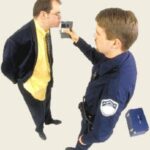If you blow a breath test for alcohol that is above the legal limit, a citation for drunk driving is inevitable. But what if you are under the legal blood alcohol limit and the arresting officer writes you a DUI citation anyway. What other tests do police use to decide whether you are impaired? Most important, how can you fight the DUI?
Roadside Testing for DUI
In addition to how well you were driving, the so-called “roadside sobriety tests” may be used by police in some states to decide whether to take you to the breath or blood alcohol testing station, or whether to issue a DUI citation despite the breath test results. The tests rely on coordination or other physical signs to judge your impairment. If you failed the roadside sobriety tests and passed the breath tests, they may be confident enough in the roadside tests to issue a citation.
Three of the tests are considered to be the most reliable, although the reported evidence of their accuracy is not strong. The research for these tests was poorly conducted and the tests’ accuracy is not much better than chance, but the tests have an aura of respectability and a tradition behind them that impresses jurors.
The heel to toe walking test, also known as “walk the line“, has you walk 9 steps along a line, then turn and return along the same line. The heel must be placed directly in front of the toe of the other foot. You are judged on your ability to follow the instructions, how well you keep your balance, if you have to stop and regain balance, and if you are flapping your arms to try to maintain balance.
For the stand on one foot test, you are asked to stand on one foot with the other foot raised about six inches, then count out loud “one thousand one, one thousand two, etc.” until asked to stop. The standard time is 30 seconds.
Either of these tests will be affected by any factor that affects your balance or concentration, such as the surface you are walking on, the weather, your normal physical coordination, current or past injuries to the feet and legs, illness, physical exhaustion, and some prescription or over the counter drugs. A very common cause of failure is the normal lack of balance that comes with allergies or upper respiratory infections that cause the inner ear to become clogged.
For the eye test (horizontal nystagmus test), the officer will ask you to follow an object with your eyes while he watches their movement. He is testing if you can track the object smoothly while looking for lack of “smooth pursuit”, strongly visible nystagmus at the end of the objects track and nystagmus beginning before 45 degrees. Nystagmus is the medical term for any twitchy or jerky movement of the eyes. Horizontal nystagmus is the normal twitching that happens when you look far to one side or the other while your head is facing forward. Under the influence of alcohol, nystagmus begins at a lesser angle.
This test is attractive to police because a simple calculation supposedly converts the angle of the gaze where nystagmus first appears directly to the blood alcohol percent. They subtract the angle from 50, and that is the blood alcohol content in percent. For example, if nystagmus starts at 41 degrees, your blood alcohol is supposedly .09 … and you are supposedly driving while impaired.
Unfortunately for the police and fortunately for the accused, the horizontal nystagmus test can be affected by many non-alcohol factors, such as inner ear problems, certain illnesses, many neurological conditions, excessive caffeine intake, eye strain, sunstroke, head trauma, and many prescription and over the counter drugs. There are at least 40 medically recognized kinds of nystagmus.
How to Fight a DUI Citation that is Based on Roadside Sobriety Tests
To contest a DUI citation that was given despite a low breath alcohol result or without any breath or blood tests, you and your lawyer have to make the roadside sobriety tests look inaccurate. You should immediately write down, to the best of your recollection, the following things: Exactly how were you told to perform the tests? What were the conditions of the road, weather and traffic? What medications had you taken before the test, even over-the-counter ones? Did you have a cold or allergy problems? Did you have a physically demanding day? Any of these factors can make you fail the field tests even when you have zero alcohol in your blood.
The NHTSA publishes a booklet called “Improved Sobriety Testing (DOT HS-806512)“, with the correct procedures for administering standardized field sobriety tests. If the arresting officer did not follow these procedures, it might be possible for your lawyer to get the results excluded or convince the jury that the tests are not accurate.
The police seldom follow the NHTSA procedures closely. Typically the training is given once during an officer’s career, and there is no refresher training to ensure that the officer still follows the procedures. Officers start to take shortcuts, or adopt a variation that they think is more accurate, and in a couple of years they have drifted away from the standard procedures.
A careful line of questioning can bring out that the procedures were not followed and give an opportunity that the tests were not properly done and
Sources:
New Proof That Field Sobriety Tests Are “Failure Designed,” Spurgeon N. Cole & Ronnie M. Cole, DWI J.: L. & SCI., Feb. 1991
Field Sobriety Tests: The Flimsy Scientific Underpinnings, Jonathan D. Cowan & Susannah G. Jaffee, DWI J.: L. & SCI., Dec. 1990






